
Jordan II was the third son of Prince Jordan I of Capua and Princess Gaitelgrima, a daughter of Prince Guaimar IV of Salerno. He was, from at least May 1109, the lord of Nocera, and, after June 1120, Prince of Capua. The date and place of his birth are unknown, but it must have been later than 1080. He was married, before 1113, to Gaitelgrima, daughter of Sergius, Prince of Sorrento, a union which allowed him to extend his influence down the Amalfi coast from his castle at Nocera.
Geoffrey of Hauteville was a Norman military leader, the second youngest son of Tancred of Hauteville by his first wife Muriella. He joined his brothers in the Mezzogiorno around 1053, arriving with his half-brothers Mauger and William. He was certainly present at the Battle of Civitate in that year.
The arimanni were a warrior class of freemen in Lombard and later Frankish Italy. In contemporary documents arimanni are sometimes denominated as liberi homines or exercitales (soldiers).
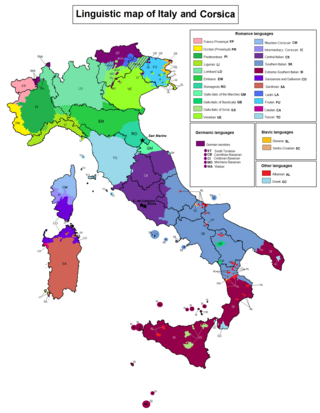
Gallo-Italic of Sicily is a group of Gallo-Italic languages found in about 15 isolated communities of central eastern Sicily. Forming a language island in the otherwise Sicilian language area, it dates back to migrations from northern Italy during the reign of Norman Roger I of Sicily and his successors.
Miriarcha is the name given in the Chronicon breve normannicum to the Byzantine general who led the defence of the Catapanate of Italy in 1060–1062. The anonymous chronicler has, however, misinterpreted the Greek title merarches as a name. The actual name of the general is unknown, and since the rank of merarches is not otherwise clearly attested in southern Italy his exact function is not known either. Probably the office was immediately below that of the catapan.

Christopher John Wickham is a British historian and academic. From 2005 to 2016, he was the Chichele Professor of Medieval History at the University of Oxford and Fellow of All Souls College, Oxford; he is now emeritus professor. He had previously taught at the University of Birmingham from 1977, rising to be Professor of Early Medieval History from 1997 to 2005.

The Norman conquest of southern Italy lasted from 999 to 1194, involving many battles and independent conquerors.
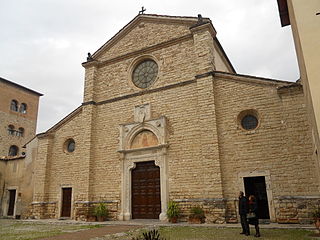
Gregory of Catino was a monk of the Abbey of Farfa and "one of the most accomplished monastic historians of his age." Gregory died shortly after 1130, possibly in 1133.
The Annales Cavenses are a chronicle compiled at the La Trinità della Cava abbey in Cava de' Tirreni, province of Salerno, southern Italy. It consists of annalistic entries spanning the years 568 to 1318, i.e. essentially the entire duration of the Middle Ages in Italy.
The Annales ianuenses or Annali Genovesi form the official history of the Republic of Genoa during the High Middle Ages. It is the earliest medieval civic chronicle and the earliest set of annals composed by a layman. The Annales form a chronological account of the history of Genoa from 1099 until 1294. The first annals were composed by Caffarus, a private citizen, on his own initiative. In 1152, he petitioned the republic to keep a copy in the public archives and thenceforth the annals were continued at public expense. Caffarus, who probably began the work around 1100, continued it himself down to 1163. A series of officials of the chancery continued the Annales between 1169 and 1197, when work was taken over by the scribe and diplomat Ogerius. He worked down to 1216; thereafter, the annalists were anonymous, and at times a committee, until the last entry was added in 1294. The public manuscript of the Annales ianuenses is now kept in the Bibliothèque nationale de France, lat. 10136.
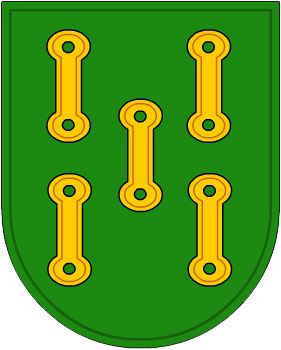
The House of Traba, sometimes called the Fróilaz-Traba, was a Galician noble family of the high Middle Ages. The family can be traced back to the eleventh century. They are associated with a castle named Traba, probably in the county of Bergantiños, and also with the county of Trastámara.
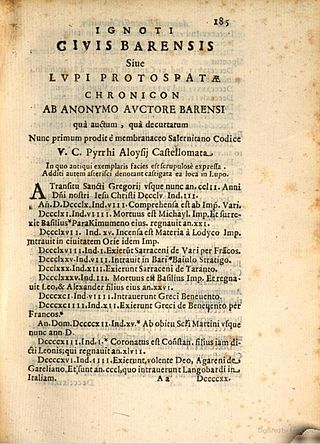
Anonymi Barensis Chronicon is a medieval Italian annalistic chronicle.

Jordan Lupin was the first count of Bovino in the Norman kingdom of Sicily. He played a major role in the final years of Norman rule and first years of the Staufer dynasty. Twice he was involved in opposing crusader armies passing through Sicily. In the second instance, he led a revolt, apparently in the hope of seizing the throne. He was successful in attracting significant support, and was even crowned anti-king, but was ultimately captured and executed.
Riccobaldo of Ferrara was a medieval Italian notary and Latin writer of the Middle Ages, a chronicler, geographer and encyclopedist. He is sometimes known in the literature as Riccobaldo da Ferrara according to the Italian form, as well as Riccobaldo Ferrarese or as Riccolbaldo.
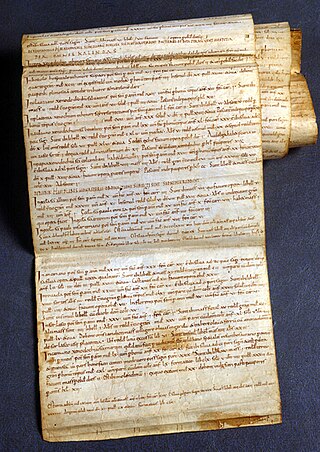
The Chronicon Novaliciense is a monastic chronicle which was written in the mid-eleventh century in the valley of Susa.
The Catalogus Baronum is a collection of registers of the military obligations owed by the barons of the Kingdom of Sicily. The collection was compiled in 1322 under the Angevin dynasty. It contains three distinct registers from different periods and covering different regions of the kingdom. The first, the Quaternus magne expeditionis, was originally compiled under the Norman king Roger II in 1150–51, then revised by his grandson, William II in 1167–68. It listed the fiefs of the crown in the Principality of Capua, the Duchy of Apulia, and the Abruzzi and detailed the services each owed. The second register was composed under William around 1175. It lists only the knights of Aquino, Arce, and Sora. The third register, the Pheudatarii iusticiaratus Capitanatae, is that of the Swabian king Frederick II from 1239–40. It lists only the feudatories of the Capitanate.
The Annales Beneventani, also called the Breve chronicon monasterii Sanctae Sophiae Beneventi or Chronicon Sanctae Sophiae for short, is a series of Latin annals from the monastery of Santa Sofia in Benevento, southern Italy. The annal entries were originally annotations written in the margins of Paschal tables, a practice that probably dates to the foundation of the monastery in the second half of the eighth century. The annotations were gathered together and copied into manuscripts in the early twelfth century. Three such manuscripts exist, each copied at Santa Sofia and each presenting a different redaction of the annals. The Annales is of interest primarily because its entries are roughly contemporaneous with the events they describe.
Peter I was the bishop of Benevento from 887 or 894 until at least 902. His pontificate was marked by rapid political shifts, with Benevento successively under Byzantine (891–895), Spoletan (895–897) and Lombard rule. Peter was imprisoned and exiled a first time in 895. He served as the regent and de facto ruler of the Principality of Benevento between 897 and 900. In 902, he was proclaimed prince by the people but refused the office and went into exile a second time. He died in 914, possibly still in exile. He was buried in Benevento
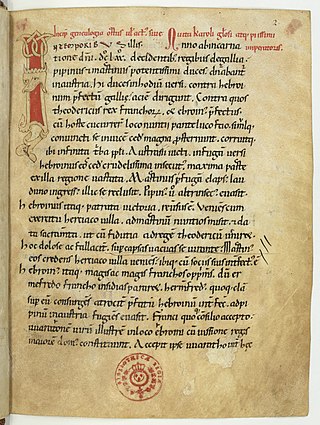
The Chronicle of Aniane is an anonymous Latin history covering the rise of the Carolingian family from 670 to 840. It was composed by a monk of the Abbey of Aniane.
Rerum italicarum scriptores ab anno æræ christianæ quingentesimo ad millesimumquingentesimum is a collection of texts which are sources for Italian history from the 6th to the 15th century, compiled in the 18th century by Ludovico Antonio Muratori.







